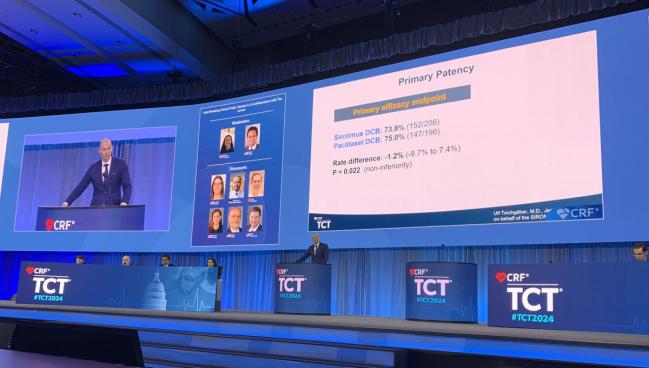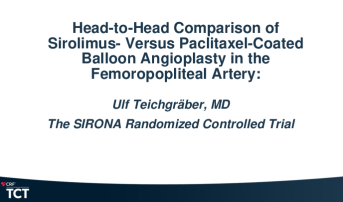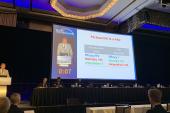SIRONA: Sirolimus and Paclitaxel DCBs Offer Similar Patency, Function in PAD
The data hint at sirolimus becoming a useful option or even a replacement for paclitaxel, but full 5-year follow-up is needed.

WASHINGTON, DC—A sirolimus drug-coated balloon (DCB) is noninferior to paclitaxel-coated DCBs for the treatment of femoropopliteal artery disease, according to data from the SIRONA trial, the first head-to-head comparison of the two technologies.
The primary patency rates between sirolimus- and paclitaxel-treated patients at 12 months showed a difference of just 1.2%, with a P value for noninferiority of 0.022, Ulf Teichgräber, MD, (University Hospital Jena, Germany), showed in his presentation here in a late-breaking trial session at TCT 2024.
During a press conference, Teichgräber said that, as a clinician, he considers the components of the primary safety endpoints to be somewhat more valuable and practical. They showed no differences in the composite of clinically driven target vessel revascularization, major target limb amputation, and device- or procedure-related death.
“The really important clinical outcome and clinical improvement with sirolimus was similar to that of paclitaxel,” he added.
The sirolimus DCB used in the study was the novel MagicTouch (Concept Medical), which is available in Europe and in trials in the United States.
“This is the first study to show in a randomized fashion that sirolimus can at least meet a similar efficacy standard, which I think is a big deal,” Sahil Parikh, MD (NewYork-Presbyterian/Columbia University Irving Medical Center, New York, NY), the session co-moderator told TCTMD. “It shows that we don't have to worry about the ability to deliver therapeutic sirolimus in the SFA, which I think opens up the possibility now for all the other sirolimus devices.”
Discussant Eric Secemsky, MD (Beth Israel Deaconess Medical Center, Boston, MA), said SIRONA is one of the most important trials in the lower-extremity space to be presented this year.
“This is a noninferiority trial; it's hard to meet superiority with a trial this size at 1 year,” he noted. “But, noninferiority is really relevant to this field.” Secemsky added that he expects that SIRONA “will inform many trials that are now either embarking or ongoing in the US in the near future.”
Functional Improvements for Most
For SIRONA, Teichgräber and colleagues compared the sirolimus DCB (MagicTouch) against seven paclitaxel DCBs commercially available in Europe (four of them are also available in the United States). The study randomized 482 patients (mean age 68 years; 35% female) from 25 clinical sites in Germany and Austria who had mean lesion lengths of 84 mm.
Approximately one-third of participants had a total occlusion, while 45% had grade 3 calcification on the peripheral artery calcification scoring system (PACSS) and nearly 30% had grade 4 calcification. Mean diameter stenosis was 83% in the sirolimus group and 82% in the paclitaxel group, and about 40% of the cohort had fewer than two runoff vessels. The majority of patients had Rutherford category 3 disease, indicative of severe claudication, with a mean axial-brachial index (ABI) of 0.6.
Predilatation was performed in all patients regardless of the DCB they received. Additionally, about one-quarter of patients in each group required more than one balloon, about one-third in each group had postdilatation, and bailout stenting was required for a flow-limiting dissection in 23% of the sirolimus group and in 20% of the paclitaxel group.
Doppler ultrasound was performed at 12 months in 88% of those who received sirolimus and in 85.5% who received paclitaxel.
The really important clinical outcome and clinical improvement with sirolimus was similar to that of paclitaxel. Ulf Teichgräber
Primary patency was preserved at 1 year in 73.8% of the sirolimus group and in 75% of the paclitaxel group. For the primary safety endpoint, the between-group difference was 2.1%, again meeting criteria for noninferiority (P = 0.003). By individual component of that endpoint, there was one major amputation in each group and 21 clinically driven TLR events in the sirolimus group and 16 in the paclitaxel group. There were no device- or procedure-related deaths in either treatment group.
Overall, freedom from clinically driven TLR was 92.9% with sirolimus and 95.4% with paclitaxel (log-rank P = 0.58).
Looking at the change in functional outcomes from baseline to 12 months, the difference between groups was just 0.1, with similar number of patients in both groups improving at least 2 Rutherford stages and approximately 89% of patients in both groups improving by 1 or more stages (P = 0.19).
Where Will We Go From Here?
After years of being the standard drug for DCBs in PAD treatment, safety concerns about paclitaxel emerged in 2018 from a meta-analysis that led to a period where paclitaxel-coated DES and DCB for peripheral interventions were taken out of use around the world. Ultimately, the mortality signal was refuted by numerous datasets, including a patient-level, pooled meta-analysis with 5-year follow-up that showed no evidence of an increased risk of death and leading to the US Food and Drug Administration removing black box warnings from paclitaxel DCBs.
Secemsky noted that the controversy has not ended, pointing to the BASIL-3 trial results presented earlier this year that showed DCB technologies, which were primarily paclitaxel-based, do not improve amputation-free survival in patients with chronic limb-threatening ischemia in comparison with plain old balloon angioplasty.
“So, we still have a role for evaluating the value of limus-based technology for peripheral vascular care in the US,” he added. Further, he said it will be necessary as that unfolds to include patients with more severe disease and to look for any potential differences between paclitaxel DCBs.
Secemsky also questioned whether a superiority trial is now warranted.
In response, Teichgräber said as far as he is concerned, the answer is no. He said the long-term data from SIRONA, which is planned out to 5 years, will answer a host of questions including assessing how sirolimus can best be utilized in below-the-knee lesions (BTK) and looking for long-term safety differences in comparison with paclitaxel. The superior safety demonstrated with limus agents in the coronaries is undisputed, Parikh noted during the session.
These are only 1-year data and it’s good stuff, but we need longer follow-up. Sahil Parikh
“Sirolimus is cytostatic and therefore immunosuppressive, so it really has healing effects to the vessel wall,” Teichgräber told TCTMD. “Paclitaxel [on the other hand] is quite aggressive and goes deep into the vessel wall and destroys [it].”
If safety is not preserved between the two arms at 5 years and sirolimus comes out ahead, Teichgräber indicated that the drug may replace paclitaxel as the drug of choice.
But, to TCTMD, Secemsky said if no difference in safety events is seen and noninferiority in terms of efficacy is maintained at 5 years, “then it's going to come down to a little bit of a market decision, and I think we've got to be practical about what we have because we have been using paclitaxel DCBs for some time.”
Parikh said there may be other factors that go into the decision at that time, including cost and more granular issues such as whether a patient has already failed paclitaxel and consideration should be given to retreatment with sirolimus.
“This is just an opening salvo, and honestly, until we see the US data, I don't think anything's going to happen,” he said. “These are only 1-year data and it’s good stuff, but we need longer follow-up.”
L.A. McKeown is a Senior Medical Journalist for TCTMD, the Section Editor of CV Team Forum, and Senior Medical…
Read Full BioSources
Teichgräber U. Head-to-head comparison of sirolimus- versus paclitaxel-coated balloon angioplasty in the femoropopliteal artery. Presented at: TCT 2024. October 29, 2024. Washington, DC.
Disclosures
- The study was supported by Concept Medical.
- Teichgräber reports grant/research support and consultant fees/honoraria from Concept Medical.
- Secemsky reports grants to his institution from Abbott/CSI, BD, Boston Scientific, Cook, Medtronic, and Philips; and speaking/consulting fees from Abbott/CSI, BD, Bristol Myers Squibb, Boston Scientific, Cagent, Conavi, Cook, Cordis, Endovascular Engineering, Gore, InfraRedx, Medtronic, Penumbra, Philips, RapidAI, Rampart, Shockwave, Terumo, Thrombolex, VentureMed, and Zoll.






Comments